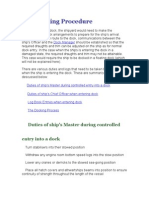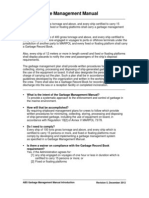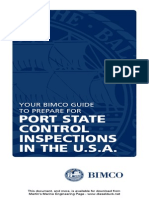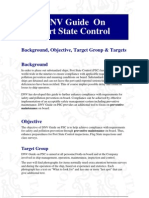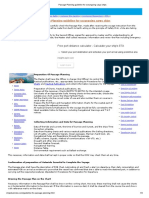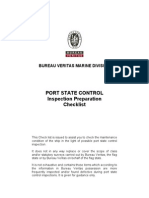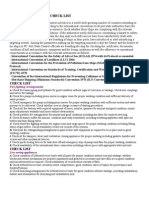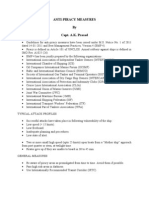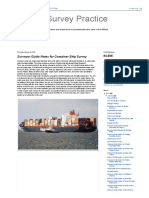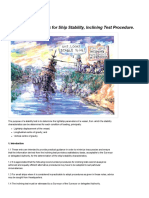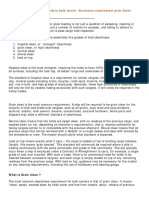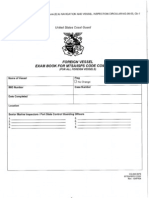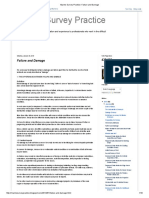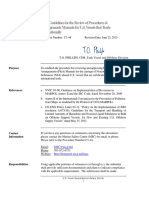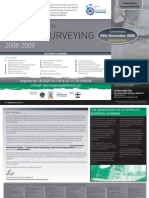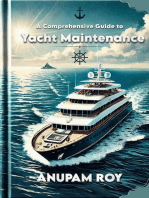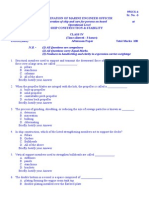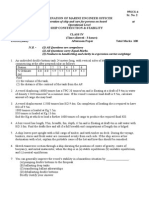0 ratings0% found this document useful (0 votes)
130 viewsThe Procedures of Dry Docking A Ship
The Procedures of Dry Docking A Ship
Uploaded by
Bhupender RamchandaniThe document describes the procedures for dry docking and undocking a ship. It involves extensive preparation and coordination between the ship's crew and shipyard personnel. When undocking, the chief officer must ensure all work is completed and the ship is seaworthy. The dock is then slowly flooded while tugs guide the ship out and turn it once cleared, after which the ship proceeds under its own power. Safety is paramount throughout the complex process.
Copyright:
© All Rights Reserved
Available Formats
Download as DOC, PDF, TXT or read online from Scribd
The Procedures of Dry Docking A Ship
The Procedures of Dry Docking A Ship
Uploaded by
Bhupender Ramchandani0 ratings0% found this document useful (0 votes)
130 views4 pagesThe document describes the procedures for dry docking and undocking a ship. It involves extensive preparation and coordination between the ship's crew and shipyard personnel. When undocking, the chief officer must ensure all work is completed and the ship is seaworthy. The dock is then slowly flooded while tugs guide the ship out and turn it once cleared, after which the ship proceeds under its own power. Safety is paramount throughout the complex process.
Original Description:
marine
Original Title
Procedures
Copyright
© © All Rights Reserved
Available Formats
DOC, PDF, TXT or read online from Scribd
Share this document
Did you find this document useful?
Is this content inappropriate?
The document describes the procedures for dry docking and undocking a ship. It involves extensive preparation and coordination between the ship's crew and shipyard personnel. When undocking, the chief officer must ensure all work is completed and the ship is seaworthy. The dock is then slowly flooded while tugs guide the ship out and turn it once cleared, after which the ship proceeds under its own power. Safety is paramount throughout the complex process.
Copyright:
© All Rights Reserved
Available Formats
Download as DOC, PDF, TXT or read online from Scribd
Download as doc, pdf, or txt
0 ratings0% found this document useful (0 votes)
130 views4 pagesThe Procedures of Dry Docking A Ship
The Procedures of Dry Docking A Ship
Uploaded by
Bhupender RamchandaniThe document describes the procedures for dry docking and undocking a ship. It involves extensive preparation and coordination between the ship's crew and shipyard personnel. When undocking, the chief officer must ensure all work is completed and the ship is seaworthy. The dock is then slowly flooded while tugs guide the ship out and turn it once cleared, after which the ship proceeds under its own power. Safety is paramount throughout the complex process.
Copyright:
© All Rights Reserved
Available Formats
Download as DOC, PDF, TXT or read online from Scribd
Download as doc, pdf, or txt
You are on page 1of 4
At a glance
Powered by AI
The document outlines the procedures for dry docking and undocking a ship, including preparations, inspections, and the step-by-step process for leaving the dock.
The Chief Officer must ensure all work is completed satisfactorily, carry out inspections, inform the Master of departure time, and sign the Authority to Flood Certificate.
Bottom plugs must be closed, sea chests checked, and ballasting done to ensure the ship does not have an even keel draught.
The Procedures of
Dry Docking a Ship
Introduction
The process is described as of a ship being dry-
docked in the graving dock type. In the case of the
other dock types, such as the floating dock, the
docking procedure is somewhat similar but it will vary
with the dock construction and may have its own
distinct features.
The ship's crew is involved in the dock entry and exit
along with the shipyard personnel. It is important that
they maintain contact with each other in order to
ensure smooth entry/exit. The ship's hief !fficer is
mostly responsible for these tasks.
There are many preparations that need to be made by
the shipyard as well as the ship owner before
docking. These include timing schedules so as to
avoid ariving with cargo on board or the ship ariving
when the dry dock is being used by another ship. The
process of docking and undocking must be conducted
with professionalism and must be cost effective for
both the ship owner as well as the shipyard. "nd as in
every operation, safety plays an important part.
The Undocking Procedure
#hen the docking work is near completion, the ships personnel as well
as the shipyard personnel will need to carry out their respective checks
on the vessel and around the dock area. !nce the ship has finished dry
docking it may not be immediately ready for normal trading. There are
many tests which must be carried out first. These tests engine tests and
sea trials and will be explained further in this section. The dry dock is
not the loading port of the ship and hence the ship would leave the dock
in the ballast condition on route to its loading port.
There are various duties and logs that need to be taken before and
when the ship is leaving the dock. These are summari$ed in the topics
descussed below%
Duties of the Chief Officer prior undocking
&nsure all the listed work is completed to a satisfactory standard. In
particular that all 'survey work' is completed, prior to leaving the dock.
To this end a final internal inspection of the vessel would be the order of
the day.
arry out an external inspection of the hull and enter the 'ry 'ock.
This final visit to the dock floor would also encompass the replacing of
any tank plugs that have been drawn. This task should not be deligated
to a (unior officer as the hief !fficer must sight all the tank plugs being
replaced.
The 'ry 'ock )anager would accompany the ship's hief !fficer on
final inspections and ensure that no vehicles, materials or personnel are
remaining in the dock, prior to commencing any flooding operation.
Inform the ship's )aster of the expected departure time and the crew
would be engaged in activities to make the vessel ready for sailing.
These activities would include odering the *avigator to plan the ships
movement from the dock, posting the sailing board and cancelling shore
leave, placing the engine room and respective personnel on standby,
carrying out checks on all navigation e+uipment and making relevant
entries into the deck and offical log books.
&nsure that a full set of tank soundings have been taken and that
ade+uate supplies of fresh water, fuel and lubricating oil are on board to
suit the ships movement needs. These tank +uantities would then be
applied to a complete stability check to ensure that the vessel has an
acceptable ,) once she floats clear of the keel blocks. -tability checks
are the sole responsibility of the ships personnel and comparison should
be made between the entry soundings when the vessel was last afloat.
"ll hatch covers would be closed up and the watertight integrity of the
uppermost deck assured. "nchors and cables would be heaved up and
stowed correctly aboard the vessel. "ll pipelines, power lines etc. would
need to be disconnected and relavent manpower should be made
available both ashore and aboard the ship in order to release these
safely and at the appropriate time.
Tugs, the marine pilot and linesmen would need to be ordered to
standby for the time of departure. -hips crew would be placed on
standby on the fore and aft ends to tend moorings.
.inally, the chief officer would sign the "uthority to .lood ertificate.
This is provided that he is satisfied that the 'ry 'ock "uthority has
completed the docking specification and that the ship is in a seaworthy
condition. This certificate should then be completed to allow the flooding
of the dock to commence.
The Undocking Process
/efore water is pumped into the dock, there are a few checks that
must be made. /ottom plugs must be closed and sea chests should be
in full working condition. "lso, ballasting of the ship must be done. This
is to ensure that the ship does not have an even keel draught 0the aft
draught is usually greater than the forward draught1.
The pump room, which is usually located at the forward end of the
dock controls the amount of water being pumped out of the dock. This is
also referred to as ballasting the dock.
The gangway is lifted sometimes by means of a crane once the dock
personnel have cleared the ship. .ire hydrants and all shore
connections are disconnected.
The forward and aft ends of the ship are attached to shore based
mooring lines which are winch controlled. " crane lifts these lines and
places them on the deck so that they can be attached. These help to
control the movement of the ship as it leaves the dock so as to ensure it
leaves smoothly.
#hen the level of seawater in the dry dock reaches the sea level, the
dock gates are opened.
" tug boat attaches a tug line to the aft end of the ship and begins to
pull the ship backwards 0out of the dock1. The shore based mooring
lines help to guide the ship smoothly out of the dock. "nother two
tugboats are on standby on either side of the ship.
!nce the ship is halfway out of the dock, the aft shore based mooring
lines are disconnected and the standby two tugboats attach themselves
to the ship by means of tug lines.
#hen the ship has cleared the dock gates, the front shore based
mooring lines are detached and the tug boats turn the ship around.
!nce the ship is some distance away from the dry dock, the tug lines
from all three tug boats are detached and the tug boats move away from
the ship. The propeller is then started and ship moves away on its own
propulsion.
You might also like
- Pellicon 2 Validation Guide PDFDocument45 pagesPellicon 2 Validation Guide PDFtakwahs12135No ratings yet
- SeamenshipDocument87 pagesSeamenshipBatuhan AlgürNo ratings yet
- Q4 - Module1 Consumer ChemistryDocument27 pagesQ4 - Module1 Consumer Chemistryjessie100% (1)
- Fact Sheet: Seafarer CertificationsDocument4 pagesFact Sheet: Seafarer Certificationshpss77No ratings yet
- Preparations For Loadline SurveyDocument2 pagesPreparations For Loadline SurveyRahul Rai100% (3)
- ABS - Special SurveyDocument16 pagesABS - Special SurveyprasetyoNo ratings yet
- Chapters of SolasDocument2 pagesChapters of SolasJayakumar SankaranNo ratings yet
- The Undocking ProcedureDocument3 pagesThe Undocking Proceduredanilo lara33% (3)
- Function: Marine Engineering at Operational LevelDocument3 pagesFunction: Marine Engineering at Operational LevelBhupender RamchandaniNo ratings yet
- Parts Catalog Af1060-1075-2060-2075-2051 (B064-065-140-141-142-143-163-228) PDFDocument312 pagesParts Catalog Af1060-1075-2060-2075-2051 (B064-065-140-141-142-143-163-228) PDFEdwin BautistaNo ratings yet
- Comparacion Center Tap Vs DoublerDocument4 pagesComparacion Center Tap Vs DoublerGustavo MarquezNo ratings yet
- The Docking Procedure: Duties of Ship's Master During Controlled Entry Into A DockDocument5 pagesThe Docking Procedure: Duties of Ship's Master During Controlled Entry Into A DockBhupender RamchandaniNo ratings yet
- CH 11 Stranding and BeachingDocument7 pagesCH 11 Stranding and BeachingAmit PandeyNo ratings yet
- Hatch Cover Maintenance PlanDocument5 pagesHatch Cover Maintenance Planvinay3972No ratings yet
- Amsa Sea Trials ChecklistDocument8 pagesAmsa Sea Trials Checklistrayman shipyardNo ratings yet
- Marine Survey Practice - Intermediate and Periodical SurveyDocument3 pagesMarine Survey Practice - Intermediate and Periodical SurveyJym GensonNo ratings yet
- How To Prepare For Vetting Inspection in The Engine Room?Document4 pagesHow To Prepare For Vetting Inspection in The Engine Room?Tankcare Marine100% (1)
- Annual Survey Checklist For Oil Chemical TankerDocument11 pagesAnnual Survey Checklist For Oil Chemical TankerrpNo ratings yet
- Garbage Management ManualDocument28 pagesGarbage Management ManualDancinosNo ratings yet
- Guidelines To Surveyor General: Hull & Machinery DetailsDocument3 pagesGuidelines To Surveyor General: Hull & Machinery DetailsRaman Saravanan100% (1)
- The Embarkation & Disembarkation of PilotsDocument17 pagesThe Embarkation & Disembarkation of PilotsJosue AlfaiaNo ratings yet
- Precision Checklist PDFDocument4 pagesPrecision Checklist PDFResianing MaritaNo ratings yet
- Bimco Us PSC GuideDocument20 pagesBimco Us PSC Guidemavericksailor100% (1)
- PSC Checklist: On Board Maintenance Check ListDocument16 pagesPSC Checklist: On Board Maintenance Check Listfredy2212No ratings yet
- PSC Preparedness and Response TrainingDocument28 pagesPSC Preparedness and Response TrainingBuddhika Naveendra100% (2)
- 0621 Pocket Guide PrintoutDocument8 pages0621 Pocket Guide PrintoutMuhammadNo ratings yet
- Preparation For Dry Docking: (As A Chief Engineer) : 27 February 2012 at 11:40Document6 pagesPreparation For Dry Docking: (As A Chief Engineer) : 27 February 2012 at 11:40Swopon ShahjahanNo ratings yet
- Dry Docking Basics CaptainsDocument20 pagesDry Docking Basics CaptainsJeet SinghNo ratings yet
- Passage Planning Guideline For Oceangoing Cargo ShipsDocument4 pagesPassage Planning Guideline For Oceangoing Cargo ShipsGerald Handerson100% (2)
- 1 - Checklist For PSC Inspections - CompleteDocument19 pages1 - Checklist For PSC Inspections - CompleteEmiliano Berriel AlcaldeNo ratings yet
- Machinery Surveys by Chief EngineerDocument3 pagesMachinery Surveys by Chief EngineerBhalchandra Chandakkar100% (1)
- Port State Control Check ListDocument3 pagesPort State Control Check Listbernardinodino100% (2)
- Dry Docking PDFDocument3 pagesDry Docking PDFDeepakNo ratings yet
- Ism Code: Mohd. Hanif Dewan, Chief Engineer and Maritime Lecturer & Trainer, BangladeshDocument34 pagesIsm Code: Mohd. Hanif Dewan, Chief Engineer and Maritime Lecturer & Trainer, BangladeshDenada Anggia Dwi Putri100% (1)
- Anti-Piracy Measures by Capt. A.K. PrasadDocument3 pagesAnti-Piracy Measures by Capt. A.K. PrasadPrashant Ramdas100% (1)
- Master Pilot ExchangeDocument5 pagesMaster Pilot ExchangeSatya Prakash BhardwajNo ratings yet
- Turk Loydu Port State Control ChecklistDocument15 pagesTurk Loydu Port State Control ChecklistOguz GundogduNo ratings yet
- Marine Survey Practice - Surveyor Guide Notes For Container Ship Survey PDFDocument5 pagesMarine Survey Practice - Surveyor Guide Notes For Container Ship Survey PDFJuanjo MarengoNo ratings yet
- Silver Fern Yacht Operations Manual 2Document47 pagesSilver Fern Yacht Operations Manual 2PH Ph Gnso100% (1)
- Chapter 5 The Multicultural ShipDocument32 pagesChapter 5 The Multicultural Shipmiguel osunaNo ratings yet
- NK Good Maintenance On Board Ships eDocument74 pagesNK Good Maintenance On Board Ships eArdyas Wisnu Baskoro100% (5)
- Ship Sanitation CertDocument1 pageShip Sanitation CertiomerkoNo ratings yet
- Vessel Conditions Report Cheka 1 - FinalDocument33 pagesVessel Conditions Report Cheka 1 - FinalCESAR VIECNTENo ratings yet
- Port State Control in Auustralia - AMSADocument61 pagesPort State Control in Auustralia - AMSAyagyabajpaiNo ratings yet
- BMA Bulletin 73 Periodic Bottom Inspection of Passenger ShipsDocument11 pagesBMA Bulletin 73 Periodic Bottom Inspection of Passenger ShipspRADEEP sNo ratings yet
- Marine Survey Practice - Surveyor Guide Notes For Ship Stability, Inclining Test ProcedureDocument11 pagesMarine Survey Practice - Surveyor Guide Notes For Ship Stability, Inclining Test ProcedureshahjadaNo ratings yet
- AMSA36Document66 pagesAMSA36Btwins123100% (2)
- PSC Pocket ChecklistDocument16 pagesPSC Pocket Checklistparamjyot_sabharwalNo ratings yet
- Marine SurveyorsDocument1 pageMarine SurveyorsNick SmithNo ratings yet
- Ocimf OvidDocument23 pagesOcimf OvidMourad Behlouli100% (1)
- Uscg Chem PDFDocument65 pagesUscg Chem PDFjbjacksparrowNo ratings yet
- Hold CleaningDocument5 pagesHold CleaningBiplab SharmaNo ratings yet
- USCG Foreign Vessel Exam. Book For MTSA-ISPS Code ComplianceDocument9 pagesUSCG Foreign Vessel Exam. Book For MTSA-ISPS Code Compliancech3g44No ratings yet
- AMSA StabilityDocument25 pagesAMSA Stabilitybhaswath2000100% (1)
- Marine Survey Practice - Failure and DamageDocument10 pagesMarine Survey Practice - Failure and DamageJym GensonNo ratings yet
- Procedures and Arrangements ManualDocument5 pagesProcedures and Arrangements ManualNishadYadavNo ratings yet
- The Life A CadetDocument8 pagesThe Life A CadetCaptNo ratings yet
- Marine Survey Practice - Initial Survey of HullDocument3 pagesMarine Survey Practice - Initial Survey of HullJym GensonNo ratings yet
- LM1333 Marine Surveying (KL)Document8 pagesLM1333 Marine Surveying (KL)majdirossrossNo ratings yet
- Code of Safe Working Practices for Merchant Seafarers Consolidated 2015 edition, including amendments 1-7From EverandCode of Safe Working Practices for Merchant Seafarers Consolidated 2015 edition, including amendments 1-7No ratings yet
- How to Abandon Ship: The World War II Classic That Can Save Your LifeFrom EverandHow to Abandon Ship: The World War II Classic That Can Save Your LifeNo ratings yet
- Task 4Document5 pagesTask 4fariskongrockefellerNo ratings yet
- Marine Engineering Study Materials: Videocon d2h HD OfferDocument6 pagesMarine Engineering Study Materials: Videocon d2h HD OfferBhupender RamchandaniNo ratings yet
- Marine Engineering Study Materials: Wall Paints in HD ShadesDocument7 pagesMarine Engineering Study Materials: Wall Paints in HD ShadesBhupender RamchandaniNo ratings yet
- 95MEP 4 Sr. No. 1Document2 pages95MEP 4 Sr. No. 1Bhupender RamchandaniNo ratings yet
- Marine Engineering Study Materials: EFC InternationalDocument5 pagesMarine Engineering Study Materials: EFC InternationalBhupender RamchandaniNo ratings yet
- Isps CodeDocument10 pagesIsps CodeBhupender RamchandaniNo ratings yet
- Function: Marine Engineering at Operational LevelDocument3 pagesFunction: Marine Engineering at Operational LevelBhupender RamchandaniNo ratings yet
- Function: Marine Engineering at Operational LevelDocument2 pagesFunction: Marine Engineering at Operational LevelBhupender RamchandaniNo ratings yet
- Marine Engineering Study Materials: Videocon d2h HD OfferDocument7 pagesMarine Engineering Study Materials: Videocon d2h HD OfferBhupender RamchandaniNo ratings yet
- Function: Marine Engineering at Operational LevelDocument4 pagesFunction: Marine Engineering at Operational LevelBhupender RamchandaniNo ratings yet
- Function: Marine Engineering at Operational LevelDocument3 pagesFunction: Marine Engineering at Operational LevelBhupender RamchandaniNo ratings yet
- Mek 2001 Jan 95 SR - No.1Document3 pagesMek 2001 Jan 95 SR - No.1Bhupender RamchandaniNo ratings yet
- Function: Marine Engineering at Operational LevelDocument2 pagesFunction: Marine Engineering at Operational LevelBhupender RamchandaniNo ratings yet
- 95 MEKM4 SR No4Document3 pages95 MEKM4 SR No4Bhupender RamchandaniNo ratings yet
- Function: Marine Engineering at Operational LevelDocument3 pagesFunction: Marine Engineering at Operational LevelBhupender RamchandaniNo ratings yet
- Function: Marine Engineering at Operational LevelDocument3 pagesFunction: Marine Engineering at Operational LevelBhupender RamchandaniNo ratings yet
- (Motor) (Time Allowed - 3 Hours) INDIA (2000) Afternoon Paper Total Marks 100Document3 pages(Motor) (Time Allowed - 3 Hours) INDIA (2000) Afternoon Paper Total Marks 100Bhupender RamchandaniNo ratings yet
- Mek 2000 March 95 SR - No.2Document2 pagesMek 2000 March 95 SR - No.2Bhupender RamchandaniNo ratings yet
- Mek 2000 April 95 SR - No.5Document2 pagesMek 2000 April 95 SR - No.5Bhupender RamchandaniNo ratings yet
- 95SCS-4 Sr. No. 6 Examination of Marine Engineer OfficerDocument3 pages95SCS-4 Sr. No. 6 Examination of Marine Engineer OfficerBhupender RamchandaniNo ratings yet
- 95 Scs 4 Sr. No.5Document3 pages95 Scs 4 Sr. No.5Bhupender RamchandaniNo ratings yet
- 95SCS-4 Sr. No. 2 Examination of Marine Engineer OfficerDocument4 pages95SCS-4 Sr. No. 2 Examination of Marine Engineer OfficerBhupender RamchandaniNo ratings yet
- 95 Scs 4 Sr. No. 9Document4 pages95 Scs 4 Sr. No. 9Bhupender RamchandaniNo ratings yet
- Ship Construction & Stability (Time Allowed - 3 Hours) INDIA (2001) Afternoon Paper Total Marks 100Document5 pagesShip Construction & Stability (Time Allowed - 3 Hours) INDIA (2001) Afternoon Paper Total Marks 100Bhupender RamchandaniNo ratings yet
- DalistDocument2 pagesDalistDoug8796No ratings yet
- Permanent Magnet Synchronous Motor (PMSM) DesignDocument47 pagesPermanent Magnet Synchronous Motor (PMSM) DesignRAMESH P (PC2013005013009)100% (1)
- Aisi A10Document2 pagesAisi A10123vigenNo ratings yet
- Axial Piston Variable Pump (A)Document60 pagesAxial Piston Variable Pump (A)cristhianNo ratings yet
- Seven Chakra ChartDocument1 pageSeven Chakra ChartPRaoNo ratings yet
- HM-02-lesson-4 (1) 9.08.21Document31 pagesHM-02-lesson-4 (1) 9.08.21VMA ChoraleNo ratings yet
- Guitar XXXXXX's Practice LogDocument41 pagesGuitar XXXXXX's Practice LogRanieque RamosNo ratings yet
- NW Model Question With AnsDocument8 pagesNW Model Question With Ansyisakabera123No ratings yet
- Tda 7266Document9 pagesTda 7266huitlamenNo ratings yet
- Therapeutic Strategies To Combat Antibiotic ResistanceDocument14 pagesTherapeutic Strategies To Combat Antibiotic ResistanceMolly0630No ratings yet
- PDFDocument450 pagesPDFazis fauzan100% (1)
- List of Electrodes - SS and Nickel AlloyDocument3 pagesList of Electrodes - SS and Nickel Alloykvmoorthi100% (1)
- Slide-Chapter 1 STDocument54 pagesSlide-Chapter 1 STpttd154No ratings yet
- The Beginner's Guide To Intermittent Fasting - and The Fascinating Science Behind This Hip Biohacking ToolDocument18 pagesThe Beginner's Guide To Intermittent Fasting - and The Fascinating Science Behind This Hip Biohacking ToolWilson Gayo100% (1)
- Mathematical Association of America, Taylor & Francis, Ltd. Mathematics MagazineDocument6 pagesMathematical Association of America, Taylor & Francis, Ltd. Mathematics Magazineenota15No ratings yet
- Oilpaint Weebly EdDocument22 pagesOilpaint Weebly Edapi-293964578No ratings yet
- RP8100Document4 pagesRP8100Ana Cecilia Gallegos PachecoNo ratings yet
- Msds CPD SikaLatex UsDocument8 pagesMsds CPD SikaLatex UsmastercssiNo ratings yet
- Design and In-Vitro Characterization of Delayed Release Multi Unit Particulates Using Wurster TechnologyDocument10 pagesDesign and In-Vitro Characterization of Delayed Release Multi Unit Particulates Using Wurster TechnologyBaru Chandrasekhar RaoNo ratings yet
- Screenshot 2024-10-01 at 9.57.25 PMDocument112 pagesScreenshot 2024-10-01 at 9.57.25 PManurobin2014No ratings yet
- MSC - Marc and MSC - Marc Mentat: Release GuideDocument112 pagesMSC - Marc and MSC - Marc Mentat: Release GuideMahmud Kori EffendiNo ratings yet
- Notes by Alakh PandeyDocument9 pagesNotes by Alakh Pandeyirfanalirind181No ratings yet
- ChampDocument2 pagesChampRavindra SharmaNo ratings yet
- Air Tractor AT-602 Airplane Flight Manual Excerpt-RelDocument1 pageAir Tractor AT-602 Airplane Flight Manual Excerpt-RelJose A. HerreraNo ratings yet
- Efficacy of Sodium Feredetate Versus Ferrous Sulfate in Iron Deficiency Anemia in Preganant WomenDocument4 pagesEfficacy of Sodium Feredetate Versus Ferrous Sulfate in Iron Deficiency Anemia in Preganant WomenAF KoasNo ratings yet
- Thermostat W3230: Function Description of W3230Document4 pagesThermostat W3230: Function Description of W3230p_venture100% (2)











